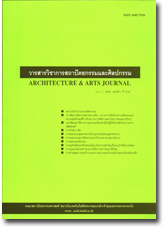Moving Autonomy The Intelligibility of Space in Architectural and Philosophical Thoughts
Main Article Content
Abstract
บทคัดย่อ
ขบวนการทางความคิดรูปแบบต่าง ๆ มีความเชื่อมโยงกันคล้ายกับความสัมพันธ์ของความรู้ในศาสตร์ต่าง ๆ สถาปัตยกรรมศาสตร์และปรัชญาได้รับอิทธิพลจากกันและกันตลอดจนมีการถ่ายทอดแนวคิดและข้อความรู้ต่าง ๆ ระหว่างกันมาโดยตลอดตั้งแต่จุดเริ่มต้นของศาสตร์ทั้งสองความเกี่ยวข้องนี้มีทั้งในด้านหัวข้อและเนื้อหาเฉพาะเช่นที่ว่างเวลาการรับรู้การมองเห็นรวมทั้งส่วนที่เป็นศาสตร์และศิลป์ที่เกี่ยวข้องต่าง ๆ ตลอดจนในด้านวิธีการ การได้มาของความคิดหรือที่เรียกว่าขบวนการทางความคิดที่ทั้งสองแขนงมีคุณภาพที่สลับซับซ้อนเปรียบได้กับเป็นงานศิลปะหรือการสร้างสรรค์ขบวนการทางความคิด วิธีการคิดทางสถาปัตยกรรมและทางปรัชญานั้นมีความเป็นวิทยาศาสตร์ในแง่ที่ทั้งสองศาสตร์ใช้วิธีการพิสูจน์สมมติฐานด้วยการสังเกตการณ์ และในขณะเดียวกันวิธีการคิดทางสถาปัตยกรรมและปรัชญาก็เป็น “ศิลปะ” ในการคิดเช่นกันเนื่องจากทั้งสองศาสตร์มุ่งค้นหาแนวทางใหม่ ๆ ทางความคิดเพื่อสร้างความเข้าใจที่ถูกต้องและลึกซึ้งขึ้นกว่าความคิดเดิม บทความนี้มีจุดมุ่งหมายที่จะแสดงให้เห็นถึงความคล้ายคลึงทางขบวนการทางความคิดในแง่มุมดังกล่าวของสถาปัตยกรรมศาสตร์และปรัชญาโดยมีจุดเน้นของการพิจารณาที่สอดคล้องกับด้านขบวนการทาง ความคิด โดยจะพิจารณาคุณสมบัติ Intelligibility ของที่ว่างเป็นหลักโดยจะแสดงให้เห็นถึงความสัมพันธ์ที่เป็นระบบ ระหว่าง ที่ว่าง เวลา ความทรงจำ การรับรู้การมองเห็น การเคลื่อนไหว และวัตถุ บทความนี้จะแสดงให้เห็นถึงความเชื่อมโยงกันทางทฤษฎีและแสดงให้เห็นถึงขั้นตอนการคิดใช้เหตุผลขั้นสูงที่เป็นเหมือน “ศิลปะ” ในการคิด โดยสื่อและใช้สื่อของการเขียน การสร้างภาพที่สะท้อนความคิด เช่น diagram และการสร้างงานสถาปัตยกรรม โดยจะใช้ตัวอย่างจากงานเขียนทางปรัชญาของเฮนรีเบิร์กสันและงานเขียนและงานออกแบบสถาปัตยกรรมของปีเตอร์ไอเซนมาน ผลงานของทั้งสองท่านมีอิทธิพลทางความคิดอย่างสูงต่อวงการสถาปัตยกรรมและปรัชญาในปัจจุบัน ซึ่งขบวนการทางความคิดนี้ เป็นขบวนการที่เป็นสากลที่อยู่นอกเหนือการพิจารณาเปรียบเทียบระหว่างสังคมและวัฒนธรรมของท้องที่ใดท้องที่หนึ่ง (regionalism) บทความนี้จะแสดงให้เห็นว่า การสร้าง Intelligibility เป็นหนึ่งในแนวทางหลักในขบวนการทางความคิดของทั้งสถาปัตยกรรมศาสตร์และปรัชญา โดยที่มีการใช้ความคิดรวบยอด (Intuition) ที่ได้พัฒนาจนเป็นระบบความคิดเป็นองค์ประกอบ สำคัญในการสร้างสรรค์และ เข้าใจแง่มุมต่าง ๆ ของผลงานทางสถาปัตยกรรมและปรัชญา
Abstract
The thinking process of different fields is aligned in the same way as theories of different sciences are related. Architecture and philosophy have been borrowing ideas and situations from each other since their beginnings. They are related not only in subjects such as space, time, perception and other human arts and sciences but they also share one of the strongest intellectual traits of the thinking process or the art of thinking. It is suggested that in their nature and procedure philosophical and architectural thinking are scientific, in the way that they prove hypotheses with observations. They are also artistic, in the way that they invent new directions of thought. The article explores the similarities between the intellectual approach and reasoning in philosophy and architecture through the subject of ‘intelligibility’ which portrays a systematic relationship between space, time, memory, perception, movement and object. This article discusses relationship between theories as sell as sequentially showing how the ‘art’ of thinking is created through writings, reflections of reality and buildings specifically through works of influential thinkers in architecture and philosophy : Peter Eisenman and Henri Bergson. This article suggests that, regardless of and beyond socio-cultural aspects of regionalism, intelligibility is the core of the architectural and philosophical process of thinking while systematic intuition is a crucial element in creating and understanding various of architecture and philosophy.
Keywords : intelligibility, space, design, memory, dynamism, movement
Article Details
This work is licensed under a Creative Commons Attribution-NonCommercial-ShareAlike 4.0 International License.
Copyright Transfer Statement
The copyright of this article is transferred to Journal of The Faculty of Architecture King Mongkut's Institute of Technology Ladkrabang with effect if and when the article is accepted for publication. The copyright transfer covers the exclusive right to reproduce and distribute the article, including reprints, translations, photographic reproductions, electronic form (offline, online) or any other reproductions of similar nature.
The author warrants that this contribution is original and that he/she has full power to make this grant. The author signs for and accepts responsibility for releasing this material on behalf of any and all co-authors.


